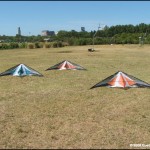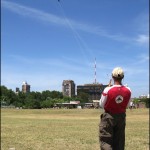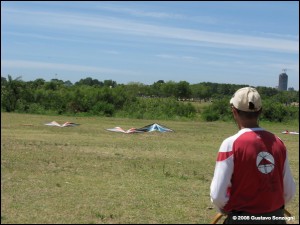MKF Part III is about a learning method to fly 3 Dual line kites at the same time with independent controls. I hope it will be a useful guide. Before you read this technical article, I really recommend re-read my previous articles about this subject :
https://www.kitelife.com/magazine/issue49/mskf49/content.php
https://www.kitelife.com/magazine/issue53/mkfII53/content.php
Remember that MKF is like team flight, meaning that allows performing our aerial ballet, but with only one pilot flying all kites. In order to become an expert with 3, you have to fly two (2) kites very well, because sometimes your eyes cannot have time to see some of your kites.
We need 3 dual line kites STD, Vented or UL, depending on weather conditions; two MKF handles, a waist belt, 3 stakes and 3 lines sets.
Learning my methodologies for 3 Dual Lines kites
Particularly, in these stages of learning, you have to fly 3 kites with moderate or slight wind. It is too important to apply safety rules of flying to avoid accidents. You have to be more careful about this condition.
Length line:
The length line depends on the pilot fly style that is why it is too important deciding what length lines we are going to use.
 Carl Bragiel (www.carlbragiel.com) flies with lines of the same length, while Ray and me different ones. I would like to remind you, that the kites generate turbulence during their flight. Because you cannot change your relative position to avoid this effect; if you decide to fly with equal length lines, the kites have to flight widely separate one from another.
Carl Bragiel (www.carlbragiel.com) flies with lines of the same length, while Ray and me different ones. I would like to remind you, that the kites generate turbulence during their flight. Because you cannot change your relative position to avoid this effect; if you decide to fly with equal length lines, the kites have to flight widely separate one from another.
Nowadays to my kites, the length lines are: Centre kite: 43 meters, Left: 40 meters and Right: 37 meters.
The Tuning:
You have to tune the kites adjusting its bridles. The Right kite faster; the left kite slower than the right one and the center is the slower than the others. That is going to be useful when you are going to do a Refuelling.
Ok, kite-mates lets go:
Step 1: “Takeoff and Landing 3 kites”
Previously, you have to check that the flying lines of each kite are equal. Then, fix the lines of your kites to the handles and waist controls and begin your training process to acquire the muscle memory. (If you want to apply Carl Bragiel´s styles watch this link: www.carlbragiel.com)
I started by my kite on waist; so I launch it at first. I always do circles, infinites, triangles and squares during 15 minutes. After that, I land it at the edge of the wind window, on two wing tips. A few seconds later, I take off again, raising the kite in stall to the zenith.
I should recommend remain the kite in its position and take the both handles to takeoff the other kites, right and left at the same time. Fly with them toward the zenith too. Another possibility is to take off the kite on waist at first, taking the handles on your hands at the same time. Do the exercises like I described, at first with waist kites, and then with others.
 OK guys, we get 3 flying. WOW!
OK guys, we get 3 flying. WOW!
Afterwards, fly slowly 3 kites to the edges of the wind window.
For example, to the left side, keeping kites in its positions. When the kites raise the left edge, fly to the opposite changing the trajectory. I mean to the right edge.
Repeat the exercises 10 times. When we decide land, do it at the edge of the wind window, one kite at time. I mean, Left kite at first, after it the centre one and so forth. By the way, you have to land 3 on wing tips.
Step 2: “In flight”
 Re-launch the 3 kites like step 1. Now, practice straight flying with your right kite remaining the other two on the zenith. Afterward, return the right kite to the starting point, and do the same exercises with the left kite and centre one. Repeat the same exercise on and on, and do not forget to keep watching kites noses to control the path. After you were finished the exercises, land to the edge of the wind window on their wingtips.
Re-launch the 3 kites like step 1. Now, practice straight flying with your right kite remaining the other two on the zenith. Afterward, return the right kite to the starting point, and do the same exercises with the left kite and centre one. Repeat the same exercise on and on, and do not forget to keep watching kites noses to control the path. After you were finished the exercises, land to the edge of the wind window on their wingtips.
Step 3: “Mix both hands and waist in flight”
Now repeat steps 1 and 2. I mean, fly straight, circles, infinites and so on, using your hands and waist, independently of the position and path of your kites. Fly continuously during 30 minutes. This training process, will improve natural movements. Eventually, practice synchronous and asynchronous maneuvers with 3 kites at the same time. Remember that when flying three simultaneously you will feel an intense kites force and speed. In this kind of flying, “feelings” is more important than “seeing”.
Video tutorial: http://www.elalmadelpiloto.com.ar/mkf/index.html
Step 4:
 Well, we get one kite in each hand and the third one on waist flying with independent controls. What interesting!Now repeat steps 1, 2, and 3 a 100 of times …until the movements became automatic… Oh! Pay attention at the body movements, because the kites will be more reactive at them. It is necessary to do easy movements and coordinate them in order to keep flight under control. You have to feel the kites and your mind have to work like a system.
Well, we get one kite in each hand and the third one on waist flying with independent controls. What interesting!Now repeat steps 1, 2, and 3 a 100 of times …until the movements became automatic… Oh! Pay attention at the body movements, because the kites will be more reactive at them. It is necessary to do easy movements and coordinate them in order to keep flight under control. You have to feel the kites and your mind have to work like a system.
What about some tricks?
Do you remember the tricks described in my article Part II?
Turtle, Fade, Flic- Flac, Yo –Yo, Belly Landing and Refuelling : http://www.elalmadelpiloto.com.ar/articles.html.
If you did it with two, you can try with three…
In fact, except Refuelling, those tricks could be possible with kites that you fly with your hands. I think that you are going to re-read my previous articles and you are going to watch the video, but I would like to explain the Refuelling with three kites.
Refuelling is one of the tricks that the audience always enjoys it…
Why? Maybe because, the pilot can show precision fly and the audience understand what you are doing. In Refuelling, the three are flying forward together, like a train…
What it works the system by 3?
In this especial train, the kites fly together without stacking one to each other. The possibilities to do are:
- You can do Refuelling remaining the centre kite at the zenith about 10 or 11.
In this case, is the kite fixing on waist (Length lines 43 meters). It has to stay at the zenith wile the first follower flies towards it.
 Which is the first follower? The first follower is the left kite. (Length lines 40 meters). You have to see the nose of the left kite pointing to trailing edge of centre, keeping the trajectory. After you get 2 on docking you have to keep the two at the zenith until the third kite is going to dock.
Which is the first follower? The first follower is the left kite. (Length lines 40 meters). You have to see the nose of the left kite pointing to trailing edge of centre, keeping the trajectory. After you get 2 on docking you have to keep the two at the zenith until the third kite is going to dock.
 Therefore, the leaders now are the centre and left kites docked. The third follower kite is the right, (Length lines 37 meters). You have to see the nose of the third pointing to the leader’s trailing edge keeping the trajectory. As soon as those are docking, moving both handles and waist at the same time and way to fly in a single entity to the right or left.
Therefore, the leaders now are the centre and left kites docked. The third follower kite is the right, (Length lines 37 meters). You have to see the nose of the third pointing to the leader’s trailing edge keeping the trajectory. As soon as those are docking, moving both handles and waist at the same time and way to fly in a single entity to the right or left.
Very Important: “Hands positions”
The hands have to stay below the lines of the centre kite. I mean, the kite stacking on waist.
Keeping three kites together you can do: squares, rectangles, circles, infinities, and triangles in a single entity. It is wonderful hear the kites in Refuelling run trough the air like a big flock. Great!
Alternatively you can do Refuelling with “three kites in continuous flying”. That maneuver is different from the first one.
 In this way the kites could be moving from different trajectories. At the beginning it could be a little difficult task, because the followers have to reach the leader (waist kite) in a non-stop flying, but with practice become easily. I should recommend docking when the three are passing from the edge of the wind window towards the centre it.
In this way the kites could be moving from different trajectories. At the beginning it could be a little difficult task, because the followers have to reach the leader (waist kite) in a non-stop flying, but with practice become easily. I should recommend docking when the three are passing from the edge of the wind window towards the centre it.
Eventually you can do Refuelling with the left and right kites and after that both docking to the centre kite.
Ok, now we have split all kites one to each other…
 Undocking:
Undocking:
I do this to undock : I move my arms that drive the right and left kites. Look, I’ll try to explain on this way: Bring both arms which are driving the right and left kite to your chest and immediately pop out quickly, at first, the right arm (right kite) forward, doing of that kite stop for seconds. Just two or three seconds later, do the same with left arm (left kite), in the same manner. You will see that the kites split of the leader (centre kite)… Amazing! Two, undocking!
After that continuing flying to you own judgment. You have to practice Refuelling (docking and undocking) several times in order to gain experience.
My friend kite-mates, I hope that this technical article it will be useful.
I would like to thank to my friend Gustavo Sonzogni for help me and to Kitelife for the opportunity that offered me to publish this article.
I hope to share with you new experiences and knowledge. Eventually I invite to express your opinion and comments to:
 http://www.elalmadelpiloto.com.ar
http://www.elalmadelpiloto.com.ar
Authors Note: The author does not assume any type of responsibility in the application of this training method; by damages in the materials of flight equipment or those can be caused by pilots during trainees, competitions or recreations flying.
Best Wishes,
Gustavo Di Si


















